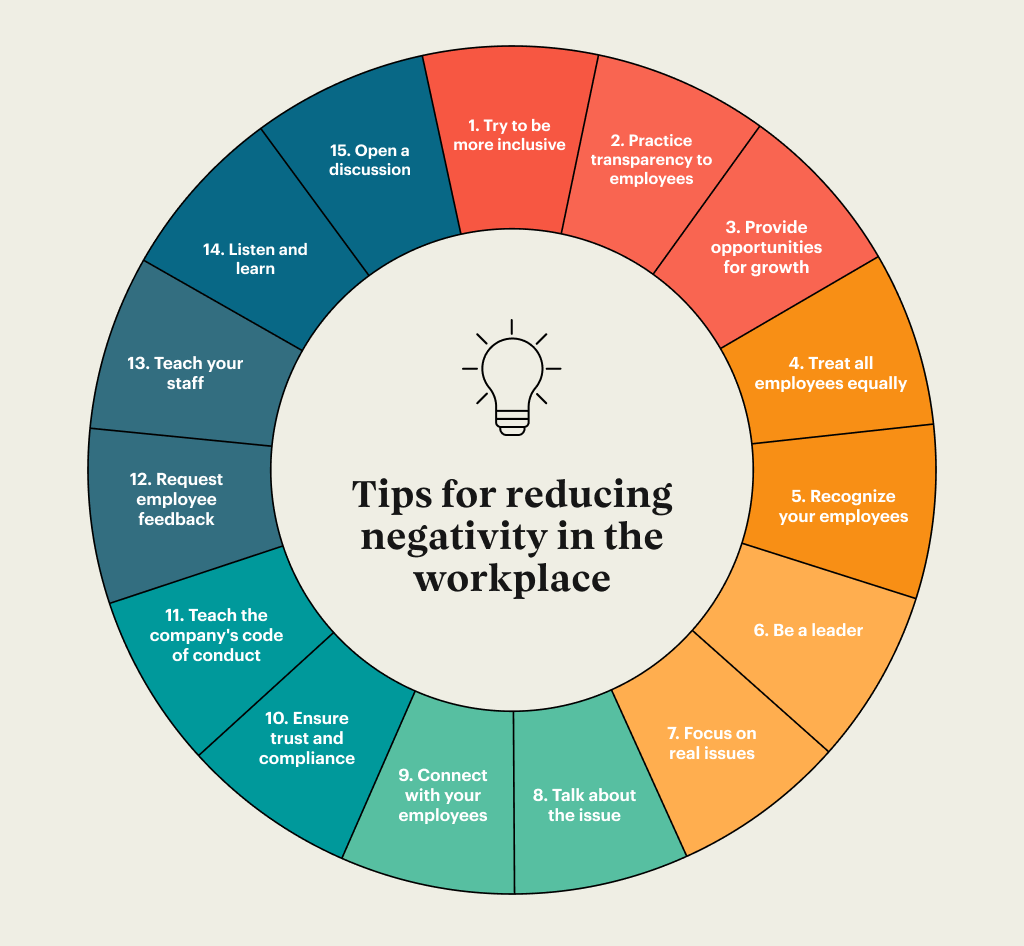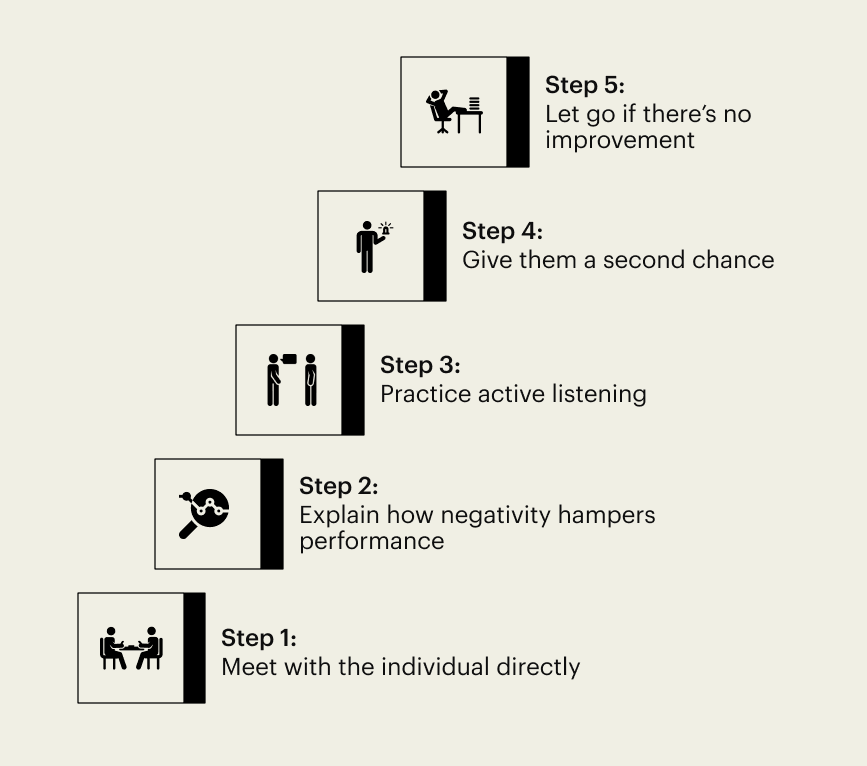Qvalon Blog article content
By: Jul Domingo
Society for Human Resource Management (SHRM) reported over $220 billion in lost earnings over the last five years resulting from employees quitting jobs due to poor company culture.
Employers often underestimate the cost of unenthusiastic employees. But this whopping figure proves that productivity and employee morale suffer when workplace negativity exists.
It’s essential to learn why the problem occurs and how to reduce it—not just for your employees’ sake but for your company’s as well. Discover the effects of negativity in the workplace and the steps you can take to stop it in its tracks.

How does workplace negativity affect businesses?
Negativity in the workplace can be a serious problem—and if not controlled, it can lead to financial issues. It costs US businesses $3 billion per year to deal with its unfavorable effects.
Staff with an unhappy or negative attitude are less likely to perform effectively or accept new challenges and responsibilities. Employee morale is vital to an organization’s productivity and profitability. Having an environment that isn’t conducive to employee satisfaction directly impacts the bottom line.
Some examples of negativity in a workplace are high-level absenteeism, failure to complete work, and refusal to collaborate with other employees
How to identify negativity in the workplace?
Finding negativity at the workplace isn't as straightforward as you might think. It’s not as if your employee comes in wearing an "I'm negative" t-shirt. Sometimes, you’ll only spot the behavior when other employees, or worse, customers get involved.
The negative behavior may start as a small interaction, but tensions tend to build up over time. And the last thing you want is for them to erupt. You need to quell that tension before things escalate.
Finding out how to avoid negativity at work begins with identifying the cause of workplace negativity. Here are three ways to do so:
Keep track of what you believe may be signs of negativity. Negativity can take various forms, such as interruptions during meetings or asking too many, irrelevant questions when going through an important subject matter.
Investigate if others on your team are experiencing the same issue. If you find that negativity is a company-wide issue, it may be time to discuss the problem openly.
Deal with the negativity head-on. This will depend on the severity of the issue. But ultimately, it doesn’t hurt to talk to the person straight away and find ways to resolve the situation.
Tips for reducing negativity in the workplace
Negative energy affects us all, especially at work. And if you don’t nip it in the bud, it can affect your entire organization. Employees might become more irritable and discouraged, resulting in more negative feelings.
There can be valid reasons people get angry sometimes. If that’s the case, then it’s easy to shove it under the rug.
However, when it happens consistently, it becomes a problem. Employees suffer the negative effects of this as well as the company's goals and culture.
In order to cope with this, here are some tips on how to get rid of negativity in the workplace:

1. Try to be more inclusive
Performance management is evolving to allow for more frequent and less formal conversations.
A recent study conducted among workers who have recently left their jobs indicates that 79% of those who have decided to leave their job cite “lack of appreciation” as the main reason.
Assist your employee in improving their performance. If the other party isn’t interested, maybe it’s time to start a dialogue about parting ways and create a transition plan.
2. Practice transparency
Employees can sense business imbalance, especially when it comes to restructuring and job loss—transparency and openness foster trust between leaders and employees.
The Conference Board discovered that nearly half of Americans are unhappy at their jobs; and a third of the workforce believes their supervisor keeps secrets from them.
People will be better able to pivot and move forward once the changes have occurred if an advanced warning that difference is in the air is given.
3. Provide opportunities for growth
To prevent negativity, you must foster a positive work environment. It reduces stress, making people happier and more productive.
A study showed that 70% of professionals with a supportive boss and a positive job experience report feeling more productive and efficient.
Acknowledge someone who has done a great job, offer incentives, or encourage learning. These simple actions will make your employees feel wanted.
4. Treat all employees equally
All employees should be treated as professionals with fairness and consistency.
According to a Central Michigan University study, 47% of American workers contend their supervisor favors certain employees and 21% of the respondents acknowledged that their supervisor treated them better than their colleagues at work.
To prevent unwanted favoritism, ensure that all employees are held to the same level of accountability and subject to the same rewards system. Furthermore, you can develop and implement policies and procedures that promote equal task distribution in the workplace.
5. Recognize your employees
Recognizing and rewarding employee achievements is an excellent way to contribute to the development of positive workplace culture.
According to a recent survey, 37 percent of employees believe that recognition is the most important factor in motivating them.
You might also consider surprising employees with small treats like donuts in the break room or even bigger rewards, such as gift cards. It won't cost much money to give these small tokens of appreciation, yet they can help them perceive their job more positively.
6. Be a leader
It’s human nature to feel like they are a part of something greater than themselves. They will be able to contribute more if they understand the vision and their role in bringing about the company’s goals
Globoforce’s survey showed that 89% of HR leaders believed that peer feedback and employee check-ins are motivational factors.
People make smarter choices for your company when you provide them with the information they need to make strategic decisions that align with your business' overall direction.
7. Focus on real issues
If something affects your employees’ work or morale, it’s necessary to address it immediately. Don’t be so quick to dismiss someone. There’s a possibility that some employees have mental health issues that influence their thinking. Reduce the problem’s impact even if you can’t make an overall change.
An SHRM survey found that 30% of managers had fired or threatened to fire someone for rudeness, and nearly 25% of employees had quit due to an unprofessional workplace.
8. Talk about the issue
Does a small percentage of employees negatively impact a workplace? Even a small handful of negative people can cause a toxic work environment, so it’s essential to get to the source of the negativity as soon as possible.
In the US, 80% of workers felt stressed because of poor communication within their companies, according to Dynamic Signal. Some people might not realize that they’re negative. For instance, some people might chalk up their behavior to a dry sense of humor.
You don’t have to confront or give ultimatums. Instead, take a collaborative approach to coach. Find out why people comment negatively and encourage them to approach and deal with problems more positively.
9. Connect with your employees
You must pay attention to employee concerns and needs. Assist them in overcoming their professional obstacles. They may lose motivation if their problems are ignored, and they are required to work continuously.
Harvard Business Review’s study about communication issues that prevent effective leadership showed that 23% of employees complain about employers who don’t inquire about their personal lives.
Having a positive relationship with your employees is important. It’s key to having a healthy corporate culture. The next time you’re in the lounge area sipping on your coffee, strike up a conversation with your staff and see how they're doing outside of work.
10. Ensure trust and compliance
You should treat your employees with confidence and respect if you want them to do the same. A Harvard Business Review shows that 58% of people trust their coworkers more than their own boss.
Don't begin by believing that people must work hard to earn your trust. Develop a sense of trust, and they will likely reciprocate it. Let them do their job and offer support—but never, ever micromanage.
11. Teach the company's code of conduct
The code defines desired behavior by articulating desired values in leaders and employees. If your company doesn’t have a clearly defined and implemented code of conduct, you’re setting yourself up to fail.
Once you’ve established the code, you should assist employees in upholding professional standards that directly reflect your company's culture and ethics. It will not only benefit them but these newly instilled values will have a positive impact on your business.
12. Request employee feedback
Employees who feel heard are happier at work. By periodically asking employees for suggestions, companies can improve the workplace environment.
Harvard Business Review recommends the upper management collect feedback monthly or quarterly. However, don’t just let your findings get covered in dust. You can use this to improve how you run the company.
There are many ways to obtain employee feedback, including surveys and polls. Using digitized tools to conduct surveys is also an option. Everything you need to know about helping your staff is at your fingertips.
13. Teach your staff
We often react to unfavorable behavior in one of two ways: ignore it or complain about it. These are natural reactions, but they aren't helpful.
Office Vibes proved that 96% of employees want regular feedback. Provide your underperforming workers with information and advice, but do not belittle or criticize them.
To make an impact and effect change, you must act and educate. If several people are having difficulty with one process or task, a collaboration tool or additional training may be helpful. Some management tools allow you to provide guidance to your staff through video calls.
14. Listen and learn
You may know a lot about your company, but your employees do too. As a result, they may become less empathetic if you don’t ask for their opinions or ignore what they say. This can lead to decreased self-esteem since they think their employers do not value their advice.
Communicating with your employees is one of the best solutions to reduce workplace negativity. According to Interact’s recent poll, 91% of 1,000 employees believe their leaders lack this ability.
When you hold your next meeting, make sure you set aside some time to hear your employees' opinions on recent events at the office. A simple gesture like this will make them feel appreciated.
15. Open a discussion
Talking to employees about their issues is the first step to identifying those who are unhappy at work.
According to a recent survey, 51% of employees blame their managers for refusing to talk to subordinates or at least hold an open forum for them.
Discuss workplace policies, such as dress code, with employees. In return, anticipate their questions and concerns. Encourage your employees to express their concerns about a specific task or operation.
How to deal with negative employees?
The success of your team and colleagues will ultimately depend on how well you handle a negative person. While negativity in the workplace can be difficult to address, you shouldn’t avoid the confrontation that comes with it.
You can manage a negative employee and sometimes even help them change their attitude. Here’s what you can do to prevent that one bad apple from spoiling the whole barrel:

Step 1: Meet with the individual directly
Talk to your negative employee one-on-one. It’s important to emphasize how his or her actions affect the entire team. Lay out the consequences of any future misbehavior, so they’ll be forewarned. Hopefully, that deters troublesome employees from stirring a hornet’s nest.
Step 2: Explain how negativity hampers performance
Negativity causes interruption in the workplace. Not only are they harming their performance, but also those around them. Enumerate the many ways this takes form—missed deadlines, late arrivals, inaccuracies, and so much more.
Step 3: Practice active listening
When you talk to your employee, make sure you give them the opportunity to explain their actions. It’s important to assure them that every individual has a personal or work issue, but being transparent about it is the first step to resolving it.
Step 4: Give them a second chance
Giving a negative employee a second chance does not excuse bad behavior. You're letting them have room for growth and experience. Before doing so, make sure that they know the problem and tell them that they can talk to you about their issues.
Step 5: Let go if there’s no improvement
When you give your negative employees a second chance, keep tabs on their performance. Note down what they are doing well and where development is needed. You should consider parting ways if you do not see improvements.
Get rid of workplace negativity
The effects of negative attitudes in the workplace are very alarming. They give rise to a culture where coworkers lack trust in one another, causing them to be careless rather than take the initiative or thrive.
This type of attitude may be disruptive and destructive for a dynamic team. The best way to reduce negativity at work is by learning how your employees think and learn. Use QVALON to monitor performance and collaborate with your staff with ease.

